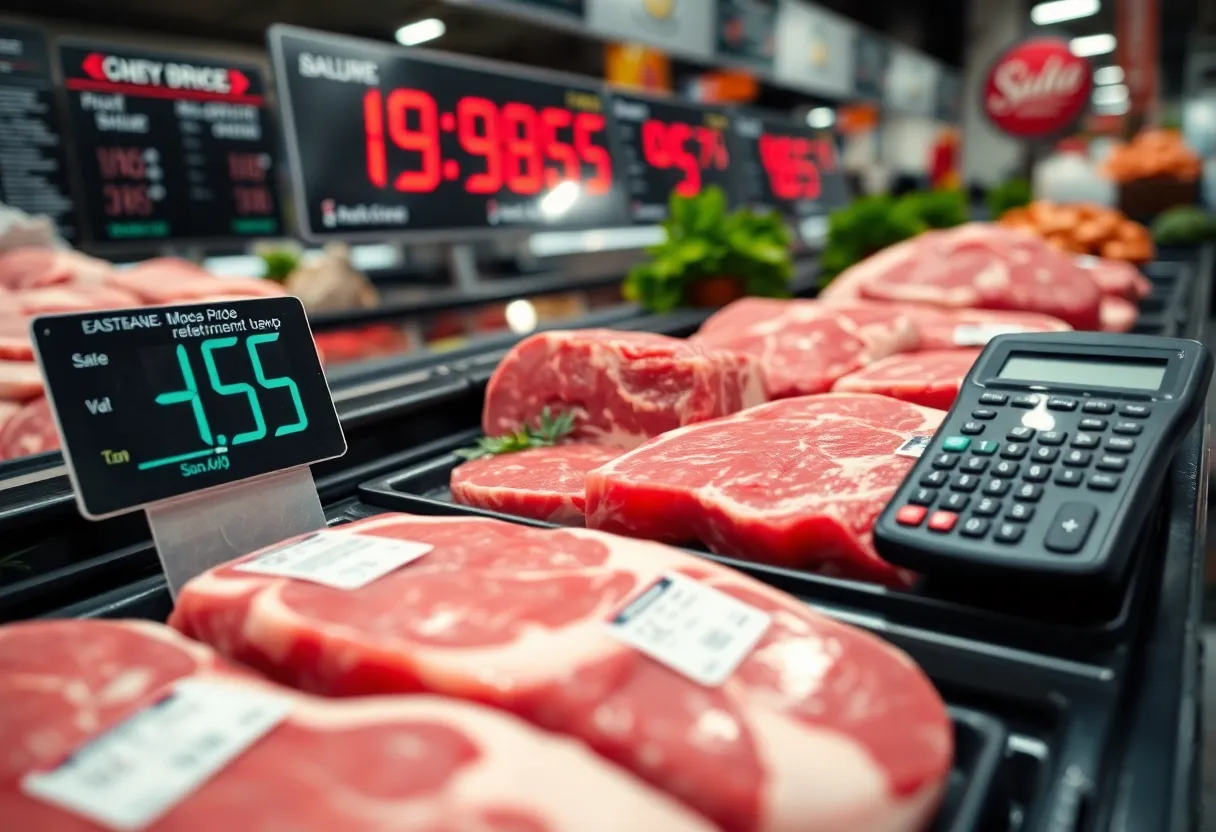Washington, D.C., November 17, 2025
Treasury Secretary Scott Bessent warns that U.S. beef prices may soar to $10 per pound by 2026, driven by disease outbreaks and long market cycles. Current beef prices have already surged significantly, raising concerns for consumers and local businesses. Despite government efforts to mitigate rising prices, industry experts predict ongoing challenges ahead.
Beef Prices Could Soar to $10 per Pound by 2026
Warnings from Treasury Secretary Ignite Concerns Over U.S. Beef Market
Washington, D.C. — In a startling announcement, Treasury Secretary Scott Bessent has indicated that ground beef prices in the United States may hit $10 per pound by the third quarter of 2026. This prediction stems from what Bessent calls a “perfect storm” of challenges facing the beef market, including disease outbreaks and extended market cycles that have harmed cattle health and production.
The rising costs of beef are not merely a temporary issue, as Bessent highlighted that the market operates in long cycles. The combination of several inherited challenges—such as a disease outbreak in Mexico—exacerbates the situation and casts a shadow on the future of beef pricing in the U.S. Not only is this troubling for consumers, but it also raises significant concerns for local businesses reliant on affordable meat products.
Current Landscape of Beef Prices
As of September, the price of ground beef surged nearly 13% compared to the same timeframe last year, with steak prices skyrocketing nearly 17%. These increases represent the largest rate of escalation observed in over three years, coinciding with a period when the inflation rate was at a critical high under previous economic conditions.
The Response from the Trump Administration
In an effort to combat these escalating prices, the Trump administration has proactively implemented measures to support food affordability. Recently, President Trump signed an executive order aimed at lowering tariffs on essential imports like beef and coffee. While these steps are commendable, the complexity of the current beef market indicates that more time and additional actions may be necessary for any substantial relief.
Industry Challenges Persist
Despite government interventions, challenges within the beef industry remain significant. Nate Rempe, the President and CEO of Omaha Steaks, has voiced concerns, suggesting that consumers may not see a decrease in ground beef prices until 2027. This forecast emphasizes the long-term difficulties that producers are likely to face as they navigate a fluctuating market burdened by ongoing health and logistical issues.
Future Price Predictions
The U.S. beef market is currently navigating a precarious terrain characterized by a combination of inherited challenges and external factors. While government actions are intended to alleviate some pressure, analysts underline the complexities inherent in the market’s structure. Consumers and businesses alike should prepare for the potential of higher prices in the years ahead, reinforcing the importance of supporting local beef producers to encourage a more resilient agricultural economy.
Key Takeaways
In summary, the U.S. beef market is facing a multitude of challenges, resulting in soaring ground beef prices and long-term forecasts predicting continued struggles. The proactive measures taken by the Trump administration indicate a recognition of the need for support in these challenging times, but the overall outlook suggests that vigilance is required as we step into the next few years.
By staying informed and supporting local beef businesses, consumers can play a role in enhancing the resilience of the industry and ensuring a steady supply of affordable meat products. Being engaged and shedding light on these issues is crucial for a bright economic outlook for New York and beyond.
Frequently Asked Questions (FAQ)
What is the current price of ground beef in the U.S.?
As of September, ground beef prices had increased by nearly 13% compared to the previous year, with steaks costing almost 17% more.
What factors are contributing to the rise in beef prices?
The rise in beef prices is attributed to a combination of factors, including disease outbreaks affecting cattle health and long market cycles.
What actions has the Trump administration taken to address rising beef prices?
The Trump administration has implemented measures such as lowering tariffs on imports like beef and coffee to alleviate rising food prices.
When are beef prices expected to decrease?
Omaha Steaks President and CEO Nate Rempe has predicted that ground beef prices may not decrease until 2027, highlighting the ongoing challenges in the sector.
What is the outlook for the U.S. beef market?
The U.S. beef market is currently facing a “perfect storm” of challenges, including disease outbreaks and market cycles, leading to concerns about rising beef prices. The Trump administration has taken steps to address these issues, but the situation remains complex.
Key Features of the U.S. Beef Market Situation
| Feature | Details |
|---|---|
| Current Ground Beef Price | Increased by nearly 13% compared to the previous year as of September. |
| Contributing Factors | Inherited challenges, including disease outbreaks affecting cattle health and long market cycles. |
| Government Actions | Implementation of measures such as lowering tariffs on imports like beef and coffee to alleviate rising food prices. |
| Industry Outlook | Omaha Steaks President and CEO Nate Rempe predicts that ground beef prices may not decrease until 2027, highlighting ongoing challenges in the sector. |
Now Happening on X
- @Washington_Rep (November 14, 2025): Despite concerns over a potential corporate exodus under Mayor-elect Zohran Mamdani, leading NYC real estate CEOs report companies are expanding office space and committing to the city. View on X
- @NTD_Live (November 13, 2025): Real estate expert Michael Romer highlights a market shift from all-cash to financed deals, with 50% of transactions now involving financing amid close monitoring of interest rates. View on X
- @TheJewishAlly (November 15, 2025): A chart illustrates the decline of New York’s finance sector dominance, with stagnant job growth in the state while other regions add thousands of positions annually. View on X
- @Variety (June 6, 2025): Actor Michael Imperioli discusses how NYC has evolved from a hub for independent businesses like restaurants and bookstores to one dominated by corporations. View on X
- @kevinolearytv (July 14, 2025): Kevin O’Leary criticizes New York as a tough place for business due to high taxes, inefficient systems, and policies that drive capital away. View on X
- @arpitrage (October 30, 2025): Indicators show NYC “definancializing” with finance jobs dropping from 12% to 7.7% of the workforce and major banks like JPMorgan shifting employment to Texas. View on X
- @BobKnakal (July 1, 2024): Bob Knakal predicts the largest sell-off in NYC history, based on extensive market analysis of Manhattan south of 96th Street. View on X
Deeper Dive: News & Info About This Topic
HERE Resources
Long Island City Welcomes Seven New Restaurants
Innovative Farming Techniques Transform Beef Production in New York
New U.S. and UK Trade Deal Announced
Chubby Cattle BBQ Brings Unique Japanese Dining to NYC
New York City Faces Fashion Crisis as Tariffs Hit Garment District
Author: STAFF HERE NEW YORK WRITER
The NEW YORK STAFF WRITER represents the experienced team at HERENewYork.com, your go-to source for actionable local news and information in New York, the five boroughs, and beyond. Specializing in "news you can use," we cover essential topics like product reviews for personal and business needs, local business directories, politics, real estate trends, neighborhood insights, and state news affecting the area—with deep expertise drawn from years of dedicated reporting and strong community input, including local press releases and business updates. We deliver top reporting on high-value events such as New York Fashion Week, Macy's Thanksgiving Day Parade, and Tribeca Film Festival. Our coverage extends to key organizations like the Greater New York Chamber of Commerce and United Way of New York, plus leading businesses in finance and media that power the local economy such as JPMorgan Chase, Goldman Sachs, and Bloomberg. As part of the broader HERE network, including HEREBuffalo.com, we provide comprehensive, credible insights into New York's dynamic landscape.





